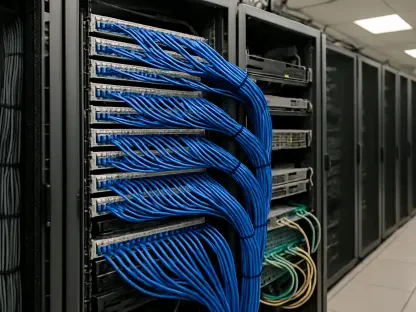In an era where edge devices like smartphones, IoT sensors, and wearables are becoming integral to daily life, the deployment of artificial intelligence directly on these gadgets marks a transformative shift in technology. Federated Learning (FL), a decentralized machine learning approach, empowers these devices to train AI models locally, eliminating the need to send sensitive data to a central server and thereby enhancing user privacy. However, a significant obstacle looms large: the limited battery life of these devices struggles to keep up with the energy-intensive demands of local training and frequent communication with edge servers. This challenge threatens the scalability and sustainability of AI at the network’s periphery. Exploring how FL can be optimized to enhance energy efficiency offers a pathway to overcoming these hurdles, ensuring that edge AI can thrive without draining resources or compromising environmental goals. This discussion delves into innovative strategies and real-world applications driving this critical advancement.
Tackling the Energy Barrier in Edge Environments
The energy demands of edge AI present a formidable challenge to the widespread adoption of Federated Learning in decentralized systems. With billions of devices generating vast streams of data daily, reliance on traditional cloud computing often results in high latency and privacy risks, necessitating solutions like FL combined with Mobile Edge Computing (MEC). However, the constant back-and-forth communication between devices and edge servers, coupled with the computational burden of training models locally, rapidly depletes battery reserves. This not only hampers device performance but also raises concerns about the environmental impact of scaling such technologies. Addressing this energy bottleneck is crucial for ensuring that edge AI remains viable and sustainable, particularly as the number of connected devices continues to grow exponentially. Without targeted interventions, the promise of low-latency, privacy-preserving AI risks being overshadowed by impractical power consumption.
Moreover, the diversity of edge devices adds another layer of complexity to the energy challenge. Smartphones, sensors, and wearables vary widely in processing power and battery capacity, making uniform energy management strategies ineffective. In FL, where each device contributes to a shared model, weaker devices can become bottlenecks, consuming disproportionate energy to keep up with training demands. This heterogeneity underscores the need for tailored approaches that account for individual device capabilities while maintaining overall system efficiency. Research indicates that without adaptive mechanisms, energy waste could undermine the scalability of FL in real-world scenarios, especially in applications like smart cities or industrial IoT. Finding ways to balance performance with power conservation across diverse edge environments is essential for unlocking the full potential of decentralized AI.
Streamlining Communication for Power Savings
One of the most effective ways to enhance energy efficiency in Federated Learning lies in optimizing communication between edge devices and servers. Techniques such as quantization and sparsification reduce the size of model updates sent during training cycles, cutting energy consumption by up to 50% in certain implementations. By compressing data before transmission, these methods minimize the power needed for wireless exchanges, a significant drain on battery life. Additionally, selective device participation ensures that only gadgets with adequate battery levels contribute to model updates, preventing overexertion of low-power units. Adaptive learning rates further refine this process by adjusting the frequency and intensity of updates based on energy availability. Together, these strategies create a more sustainable framework for FL, ensuring that communication does not become a prohibitive cost in terms of power usage.
Beyond compression and selective participation, intelligent scheduling of communication rounds offers another avenue for energy conservation. Instead of constant or uniform updates, FL systems can prioritize critical data exchanges and delay non-essential ones until devices are in optimal conditions, such as when plugged into a power source. This approach reduces unnecessary strain on batteries during peak usage times and aligns data transmission with energy availability. Furthermore, innovations in network protocols, such as leveraging low-power wireless standards, complement these efforts by ensuring that even compressed updates are transmitted with minimal energy overhead. As edge AI continues to evolve, refining communication efficiency remains a cornerstone of making FL a practical solution for power-constrained environments, paving the way for broader adoption across various sectors.
Harnessing Hardware and Offloading Strategies
Hardware-aware approaches and task offloading stand out as vital mechanisms for reducing energy consumption in Federated Learning at the edge. By shifting computationally intensive tasks from battery-limited devices to more robust edge servers, FL systems can significantly lower the power burden on individual gadgets. This strategy not only extends device lifespan but also reduces latency, as processing happens closer to the data source through Mobile Edge Computing frameworks. The trend of deploying powerful servers at the network’s edge aligns seamlessly with FL’s decentralized nature, allowing devices to focus on lighter tasks while offloading heavier computations. Such a division of labor ensures that energy is used judiciously, making AI deployment more feasible on resource-constrained hardware without sacrificing performance.
Additionally, tailoring FL implementations to specific hardware capabilities enhances overall energy efficiency. Devices with varying processors and energy profiles benefit from customized training algorithms that match their capacity, preventing overuse of power on weaker units. For instance, optimizing neural network architectures to run efficiently on low-power chips can drastically cut energy needs during local training. Meanwhile, edge servers equipped with energy-efficient hardware further support offloading by handling aggregated model updates with minimal power draw. This synergy between hardware optimization and strategic task distribution creates a balanced ecosystem where energy waste is minimized. As technology advances, integrating hardware-aware designs into FL will likely become a standard practice for sustainable edge AI, addressing both operational and environmental concerns.
Advancing Through Algorithms and Structural Innovations
Algorithmic breakthroughs are reshaping how Federated Learning achieves energy efficiency in edge AI applications. Techniques like reinforcement learning enable dynamic task allocation, ensuring that computational loads are distributed based on device energy levels and network conditions, thus preventing unnecessary power drain. Deep federated learning models further refine this by optimizing training processes to balance accuracy with energy costs. Meanwhile, hierarchical FL frameworks introduce edge nodes as intermediaries, reducing direct communication between devices and central servers, which cuts down on energy-intensive data exchanges. These innovations collectively create a more adaptive and power-conscious approach, addressing the unique challenges of heterogeneous edge environments and pushing the boundaries of what decentralized AI can achieve.
Another promising development is the concept of “Green Federated Learning,” which prioritizes eco-friendly AI by minimizing computational footprints in wireless networks. Studies suggest that such approaches can yield energy savings of 30-40%, a significant step toward sustainability. Intelligent scheduling and resource allocation algorithms play a crucial role here, ensuring that tasks are executed only when energy conditions are optimal. Additionally, integrating fog computing with FL offers secure aggregation methods that further reduce communication overhead. These structural and algorithmic advancements highlight a growing focus on aligning technological progress with environmental responsibility. As research continues to refine these methods, the vision of energy-efficient, scalable FL becomes increasingly attainable, promising a future where edge AI operates with minimal ecological impact.
Industry Applications and Future Pathways
The tangible benefits of energy-efficient Federated Learning are already evident in various industry applications, underscoring its transformative potential. Telecommunications giants like ZTE have leveraged FL to achieve notable energy savings in radio access networks, optimizing power usage while maintaining performance. Similarly, partnerships in decentralized AI have demonstrated cost reductions and speed improvements by utilizing distributed nodes for model training, aligning with FL’s core principles. These real-world successes illustrate how energy optimization in FL can drive operational efficiency across sectors like smart cities, personalized healthcare, and industrial IoT. The ability to deploy AI on edge devices without excessive power consumption opens doors to innovative applications, from real-time traffic management to remote patient monitoring, all while adhering to privacy and sustainability goals.
Looking ahead, the collaboration between academia and industry emerges as a critical driver for further advancements in energy-efficient FL. Joint efforts are translating complex research into practical solutions, such as intelligent task offloading in multi-server edge networks and scalable frameworks for diverse device ecosystems. The growing emphasis on “green AI” reflects a broader societal shift toward reducing technology’s environmental footprint, with FL positioned as a key enabler. As challenges like limited battery life and varying connectivity persist, continued innovation in communication protocols, hardware integration, and algorithmic design will be essential. These developments, built on the foundation of past efforts, promise to redefine edge AI, ensuring it remains a sustainable and powerful tool for the future of computing.









